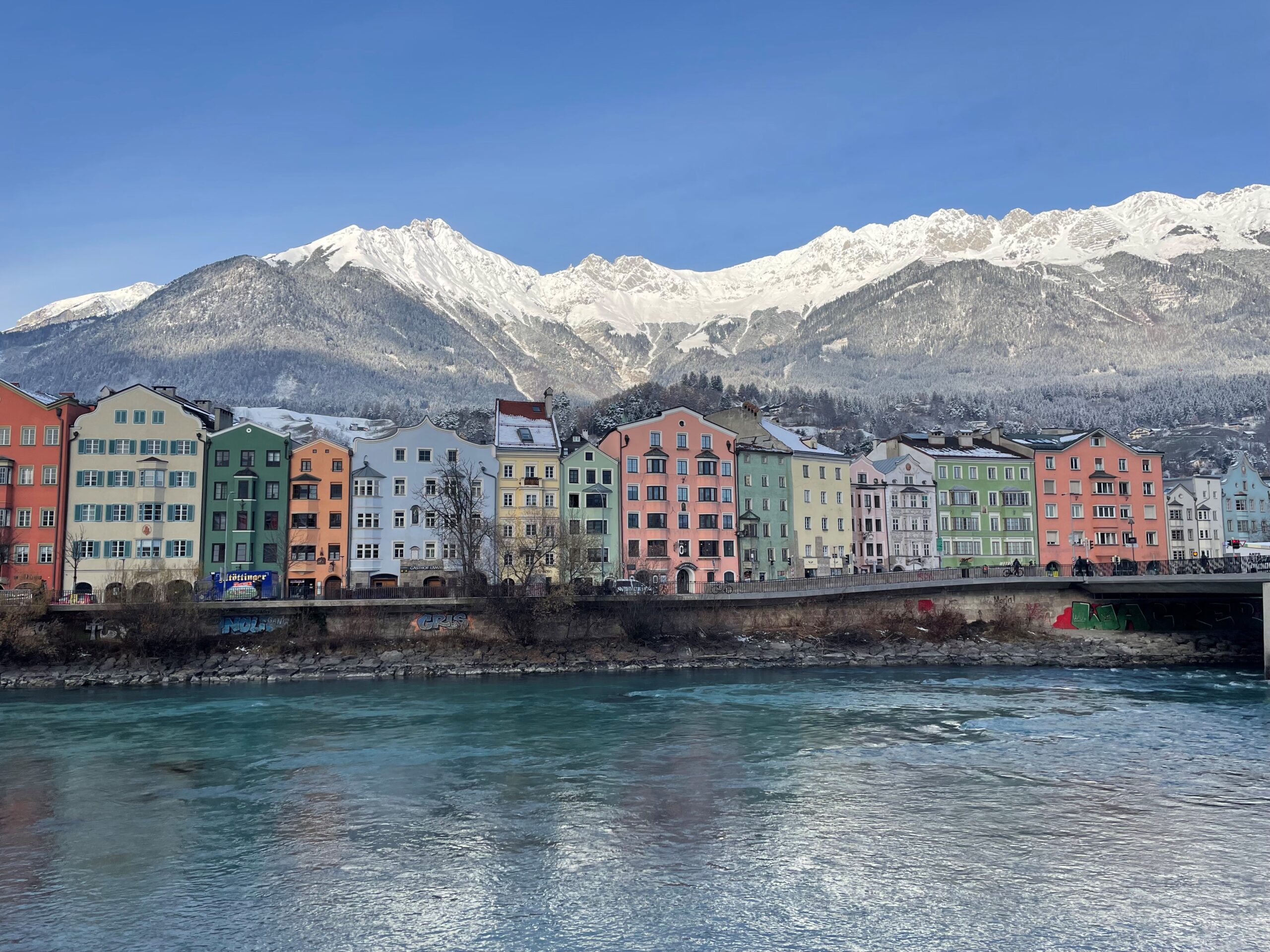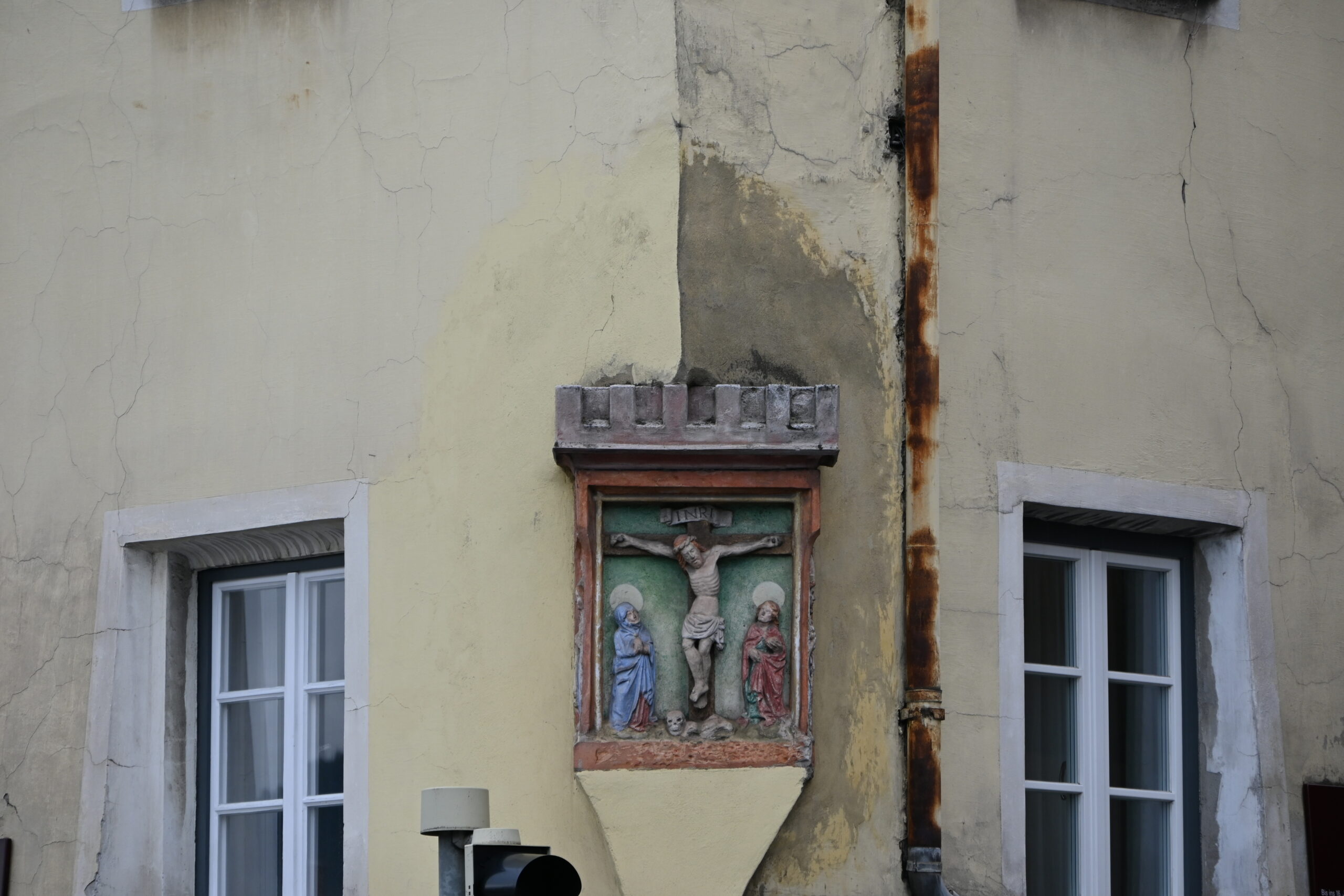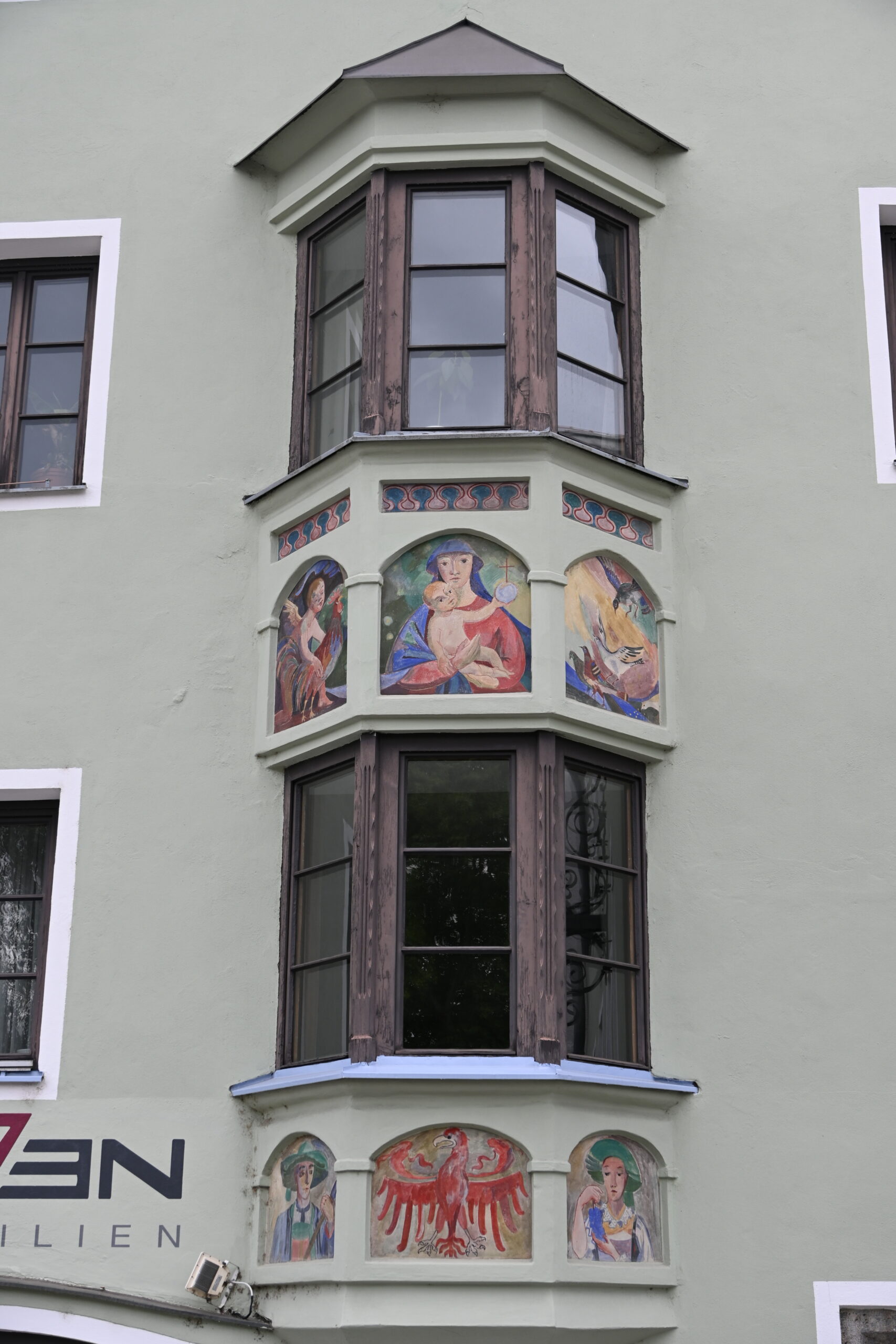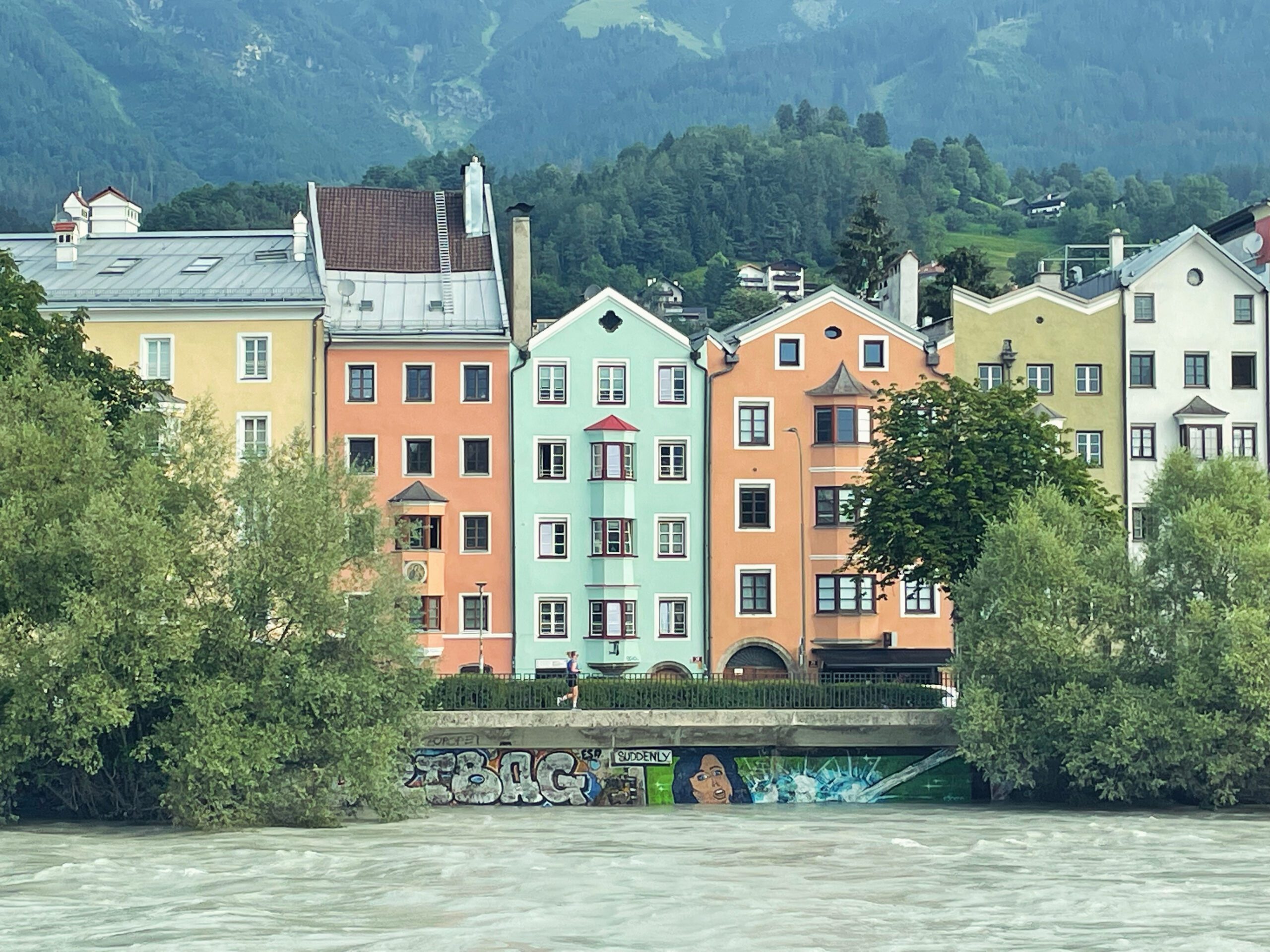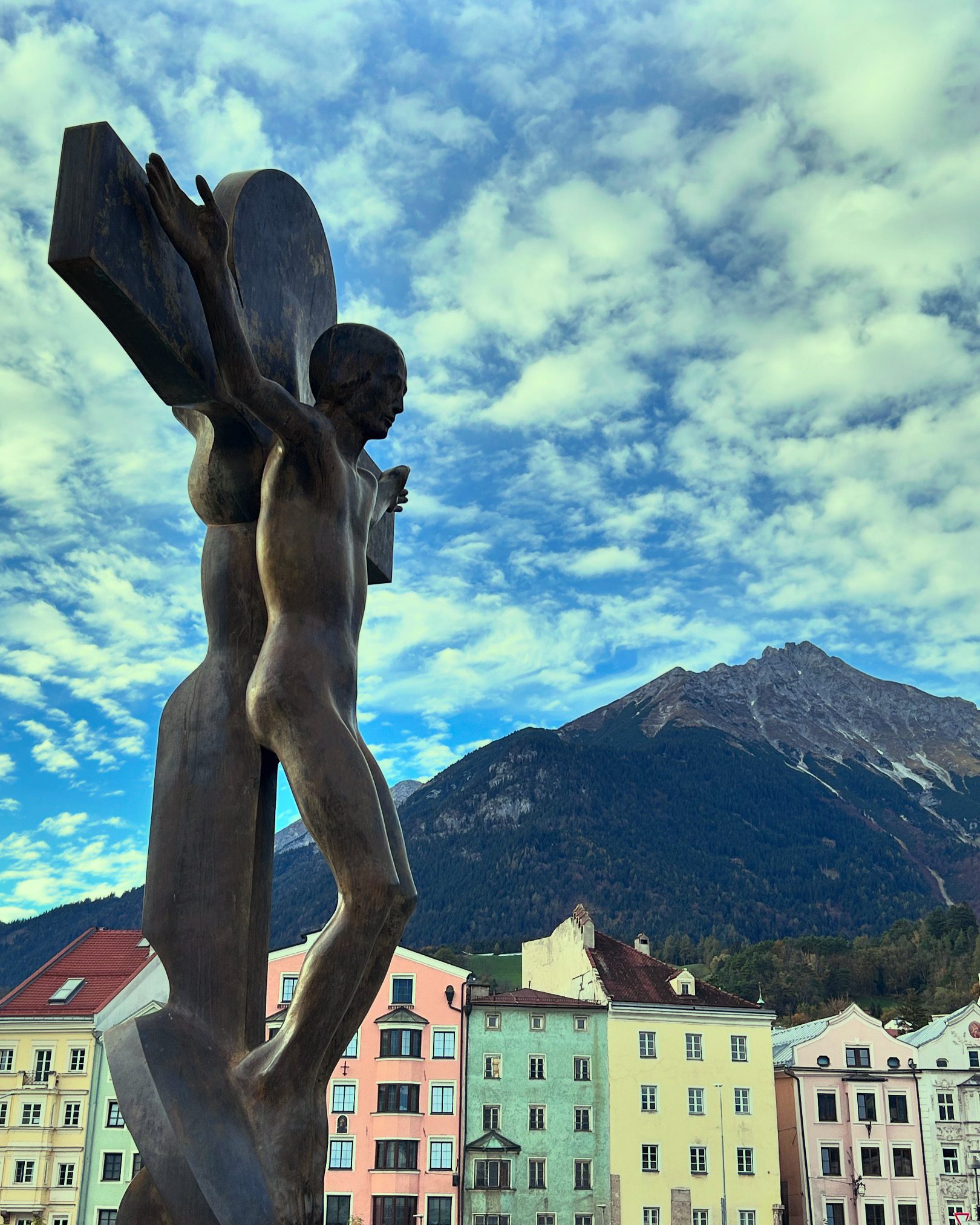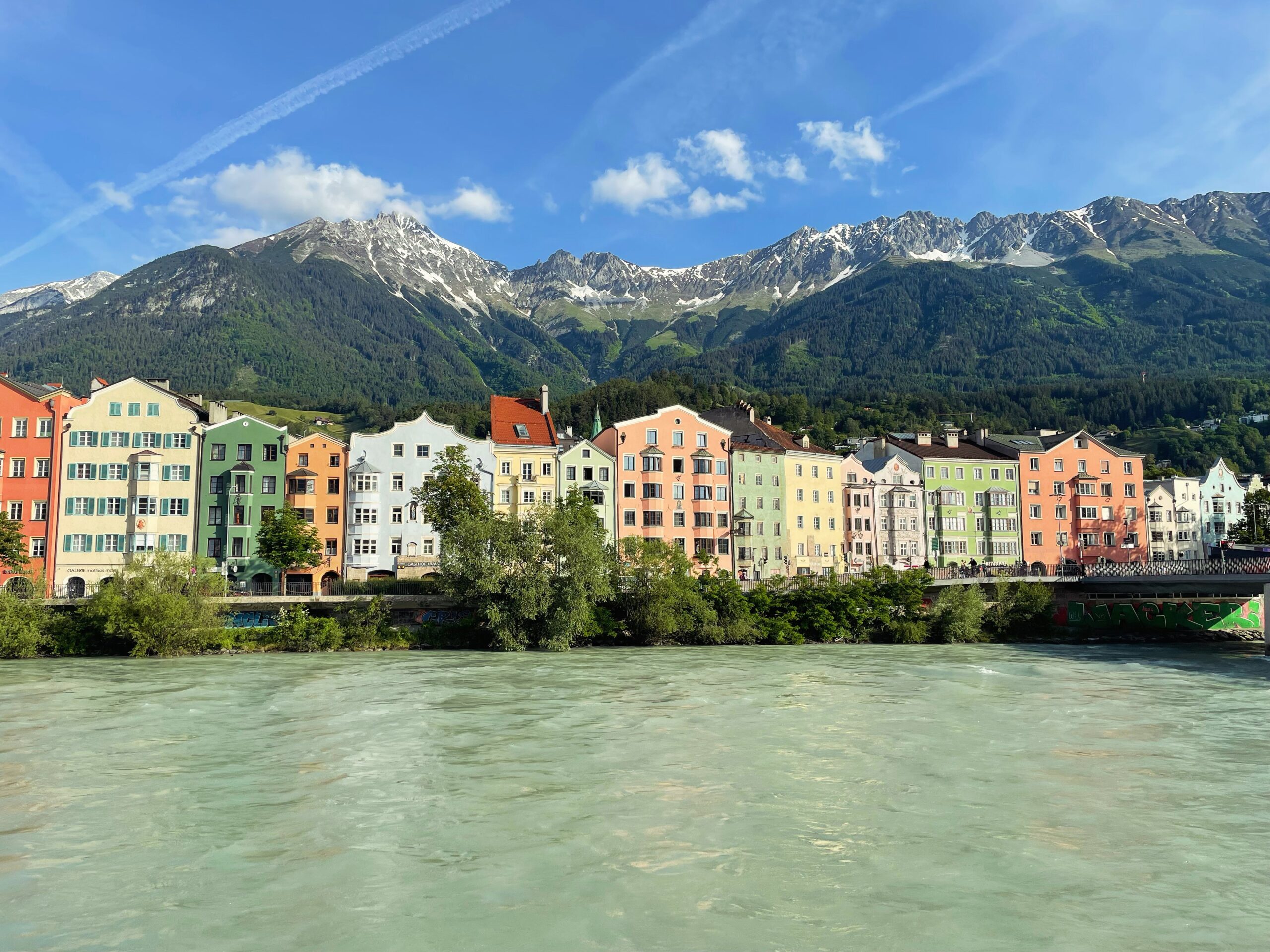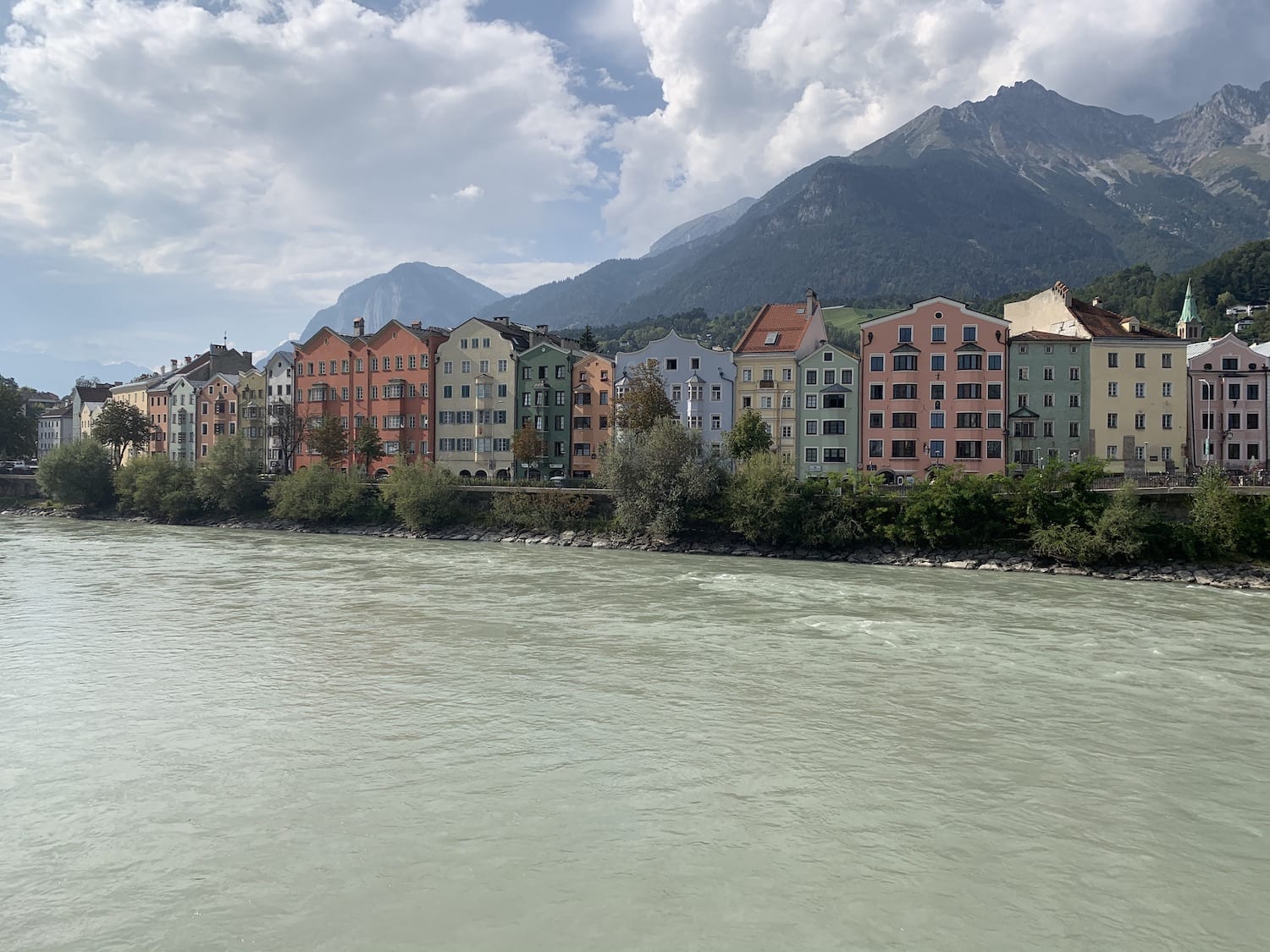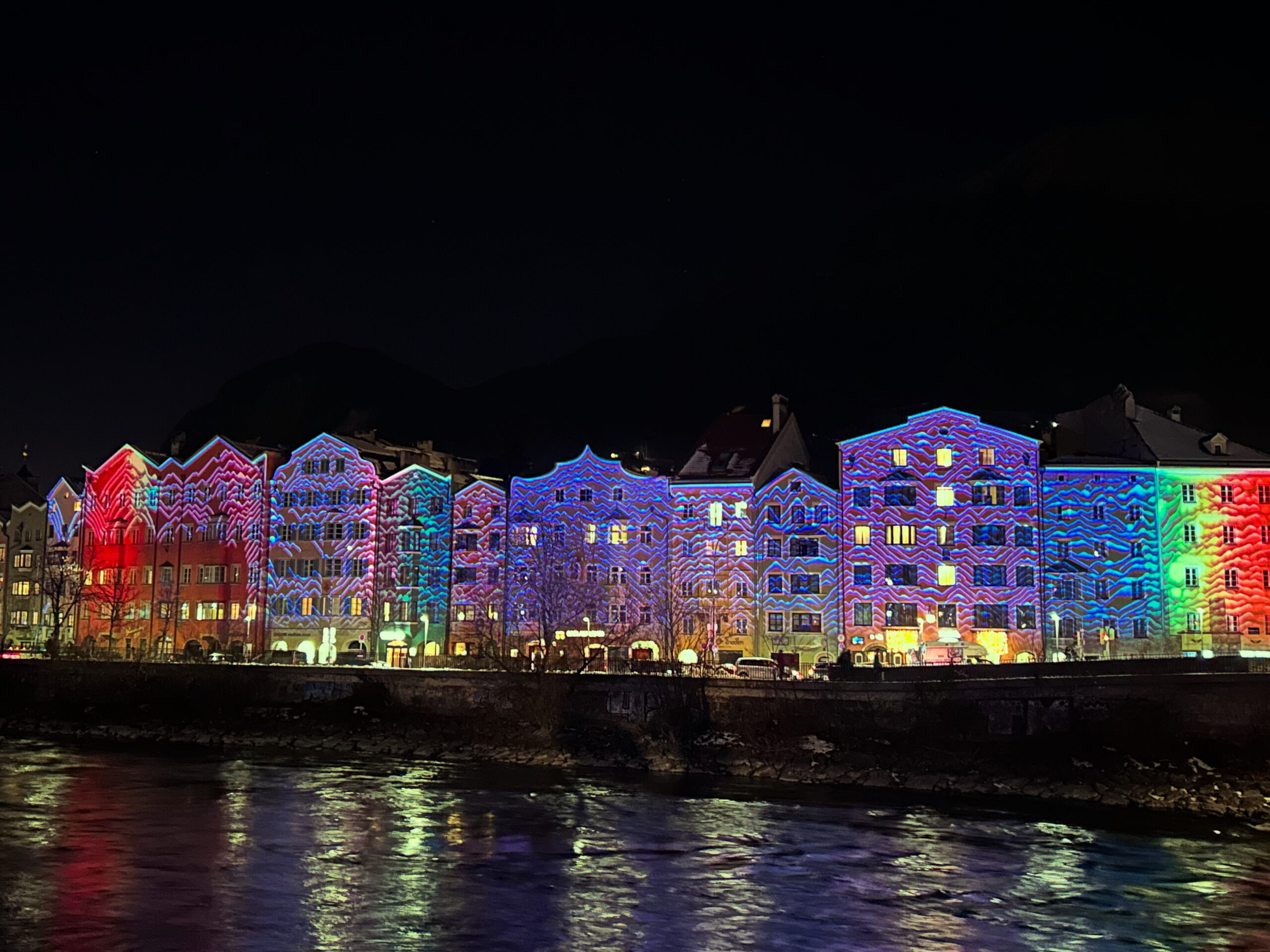Mariahilfzeile & Marketplace
Mariahilfstraße / Herzog-Siegmund-Ufer 1
Worth knowing
The Mariahilfzeile is one of Innsbruck's landmarks. Together with the River Inn and the Nordkette mountain range in the background, it forms a unique ensemble. The colourful houses seen from the market square across the Inn are among the city's most popular photo motifs. Almost the entire ensemble between the Metropolkino cinema and the fountain in front of house number 48 is a listed building. On the corner of Höttinger Gasse and Innstraße, you can see what is perhaps the oldest Marterl Innsbruck from the early 15th century. Not only Jesus, Mary and St John are depicted, St Nicholas is also part of this remarkable sculpture. No wonder, as he was the patron saint of carters, pilgrims and travellers. The square at the Inn Bridge, a transport hub and popular meeting place outside the city walls for all travellers, was ideal for sending a prayer to him.
After the alluvial plain was drained in the 16th century, inns and craft businesses often set up along the new main transport route in the narrow buildings to provide travellers with the best possible service. Some of these still exist today, others can only be guessed at. The Gasthof zum Weißen Lamm offered his services to travellers as early as 1688, the Hotel Mondschein proudly bears the year 1473 on its beautiful street sign, while the façade of Mariahilferstraße 14 shows a blacksmith at work. The façade of house number 34 still bears the lettering of the Gasthof zum Mohren. Until 1980, house number 40 was an inn with the resounding name Beer joggl in operation.
In 1809, Tyrolean insurgents launched attacks from Mariahilf against the Bavarian troops stationed in Innsbruck. Riflemen entrenched themselves in the houses and took the town under fire. The Mariahilfzeile had become a fortress, but was hardly affected. More devastating were the air raids during the Second World War. Fortunately, it was decided to renovate the affected buildings to their original appearance instead of rebuilding them as in other neighbourhoods. The block owes its strangely concerted appearance to this renovation. The varied colour scheme from the 1950s and the uniform height of the four- and five-storey buildings are the reason for the special aesthetics of the oldest part of Innsbruck. You can still see the drab original colours in old photos.
The best view of the Mariahilfzeile with its colourful houses is from the market square. For a long time, the market was located within the city walls on the Common place where the stalls of the Christmas market are now located once a year. Until the 15th century, goods were offered for sale on wooden stalls, only then did the shops develop under the arcades. Although there was also agriculture within the city walls, this was nowhere near enough to supply the city's population. Farmers from the surrounding communities offered their goods for sale at the market. The organisation of the market was regulated and controlled by the town council, as were the goods on offer. In the 16th century, the weekly market moved to Rennplatz in front of the Hofburg. It was not until the 17th century that Innsbruck's weekly market was moved outside the city gates due to a lack of space and settled on the Innrain. The market hall was a reaction to recurring protests from the population about the rapidly rising food prices since the 1870s. In 1912, Innsbruck's municipal council decided to build a public wholesale market hall next to the former meat bank on the Innrain, where a wholesale meat market was to be housed. Together with the slaughterhouse in Saggen, which opened in 1910, it was to revolutionise the prices, hygiene and availability of food in Innsbruck. The market hall as we know it today was built under Eduard Klingler and Jakob Albert, the two most important city officials under Mayor Wilhelm Greil. The older, now listed part was planned by Fritz Konzert (1877 - 1964), who had already worked with Eduard Klingler on the extension to today's HTL in Anichstraße. Like Klingler, he was also a municipal civil servant, having worked for several years as a civil engineer on railway projects under Josef Riehl. Concert's architecture displays a remarkable stylistic breadth throughout his entire creative phase. The secondary school he planned in Müllerstraße is neoclassical, the municipal swimming pool in Salurnerstraße was designed in Art Nouveau style and the municipal indoor swimming pool in the avant-garde style of the Neuen Sachlichkeit. Like the extension to the HTL in Anichstraße, the market hall is a sober, functional building. A quarter of the market hall's construction costs were spent on the elaborate refrigerated hall. The façade of the old market hall is somewhat obstructed, but from the Herzog-Siegmund-Ufer it is still a relic from the last days of the monarchy that is well worth seeing. Konzert, with its very modern approach for the time, was the first major building to be built without any grand flourishes, anticipating a new era of architecture. The eastern, modern part was added in 1960. What is now a hip food market for high earners was an important supply point for the people of Innsbruck when it was built, at a time when there were no supermarkets. Today, the market square regularly hosts sporting events and events such as the Christmas market and the fish market.
Maria help Innsbruck!
The veneration of saints and popular piety always walked a fine line between faith, superstition and magic. In the Alps, where people were more exposed to the almost inexplicable environment than in other regions, this form of faith took on remarkable and often bizarre forms. Saints were invoked for help with various everyday tasks. St Anne was supposed to protect the house and hearth, while St Notburga of Rattenberg, who was particularly popular in Tyrol, was prayed to for a good harvest. When fertilisers and agricultural machinery were increasingly used for this purpose, she rose to become the patron saint of women wearing traditional costumes. Miners entrusted their fate in their dangerous job underground to St Barbara and St Bernard. The chapel at the manor houses in Halltal near Innsbruck provides a fascinating insight into the world of faith between Begging spirit and worship of various local patron saints. The saint who still outshines all others in terms of veneration is Mary. From the consecration of herbs at the Assumption of Mary to the right-turning water in Maria Waldrast at the foot of the Serles and votive images in churches and chapels, she is a favourite permanent guest in popular piety. If you take a careful stroll through Innsbruck, you will find a special image on the facades of buildings time and again: the Gnadenbild Mariahilf by Lucas Cranach (ca. 1472 - 1553).
Cranach's Madonna is one of the most popular and most frequently copied depictions of Mary in the Alpine region. The painting is a reinterpretation of the classic iconographic Mother of God. Similar to the Mona Lisa da Vinci, which was painted at a similar time, Mary smiles mischievously at the viewer. Cranach dispensed with any form of sacralisation such as a crescent moon or halo and has her appear in contemporary everyday clothing. The red-blonde hair of mother and child transports her from Palestine to Europe. The saint and virgin Mary became an ordinary woman with a child from the upper middle class of the 16th century.
The creation, journey and veneration of the Mariahilf miraculous image tell the story of the Reformation, Counter-Reformation and popular piety in the German lands in miniature. The odyssey of the painting, which measures just 78 x 47 cm, began in what is now Thuringia at the royal court, one of the cultural centres of Europe at the time. Elector Frederick III of Saxony (1463 - 1525) was a pious man. He owned one of the most extensive collections of relics of the time. Despite his deep roots in the popular belief in relics and his pronounced penchant for Marian devotion, he supported Martin Luther in 1518 not only for religious reasons, but also for reasons of power politics. Free passage from the powerful prince and accommodation at Wartburg Castle enabled Luther to work on the German translation of the Holy Scriptures and his vision of a new, reformed church.
As was customary at the time, Friedrich also had a Art Director in his entourage. Lucas Cranach had been a court painter in Wittenberg since 1515. Like other painters of his time, Cranach was not only extremely productive, but also extremely enterprising. In addition to his artistic activities, he ran a pharmacy and a wine tavern in Wittenberg. Thanks to his financial prosperity and reputation, he was mayor of the town from 1528. Cranach was regarded as a quick painter with great output. He recognised art as a medium for capturing and disseminating the spirit of the times. Like Albrecht Dürer, he created popular works with a wide reach. His portraits of the high society of the time still characterise our image of celebrities today, such as those of his employer Frederick, Maximilian I, Martin Luther and his colleague Dürer.
Cranach and the church critics Philipp Melanchthon and Martin Luther met at Wittenberg Castle. It was through this acquaintance at the latest that the artist became a supporter of the new, reformed Christianity, which did not yet have an official manifestation. The ambiguities in the religious beliefs and practices of this period before the official schism are reflected in Cranach's works. Despite Luther and Melanchthon's rejection of the veneration of saints, the cult of the Virgin Mary and iconographic representations in churches, Cranach continued to paint for his patrons according to their taste.
Just as unclear as the transition from one denomination to another in the 16th century is the date of origin of the The miraculous image of Mariahilf. Cranach painted it sometime between 1510 and 1537 either for the household of Frederick's sister-in-law, Duchess Barbara of Saxony, or for the Church of the Holy Cross in Dresden. Art experts are still divided today. The friendship between Cranach and Martin Luther suggests that Cranach painted it after his conversion to Lutheranism and that this secularised depiction of a mother and child is an expression of a new religious world view. However, it is entirely possible that the business-minded artist painted the picture without any ideological background, but as an expression of the fashion of the time even before Luther's arrival in Wittenberg.
After Frederick's death, Cranach entered the service of his successor, John Frederick I of Saxony. When his employer was taken prisoner by the emperor after the Battle of Mühlberg in 1547, court painter Cranach followed him to Augsburg and Innsbruck despite his advanced age. After five years in the wake of the hostage, who was probably housed in luxury, Cranach returned to Wittenberg, where he succumbed to his biblical age by the standards of the time.
The Gnadenbild Mariahilf was transferred to the Kunstkammer of the Saxon sovereign during the turbulent years of the confessional wars, probably to save it from destruction by zealous iconoclasts. Almost 65 years later, like its creator before it, it was to find its way to Innsbruck along winding paths. When the art-loving Bishop of Passau from the House of Habsburg was a guest at court in Dresden in 1611, he chose Cranach's miraculous painting as a gift and took it with him to his prince-bishop's residence on the Danube. His cathedral dean saw it there and was so impressed that he had a copy made for his home altar. A pilgrimage cult quickly developed around the picture.
When the Bishop of Passau became Archduke Leopold V of Austria and Prince of Tyrol seven years later, the popular painting moved with its owner to the court in Innsbruck. His Tuscan wife Claudia de Medici kept the cult of the Virgin Mary in the Italian tradition alive even after his death. Both the Servite Church and the Capuchin monastery were given altars and images of the Virgin Mary. However, nothing was more popular than Cranach's miraculous image. In order to protect the city during the Thirty Years' War, the image was often taken from the court chapel and displayed for public veneration. During these mass prayers, the desperate population of Innsbruck shouted a loud "Maria Hilf" ("Mary Help") at the small painting, a practice that had become part of popular belief thanks to the Jesuits. In 1647, at the moment of greatest need, the Tyrolean estates swore to build a church around the painting to protect the country from devastation by Bavarian and Swedish troops. The fact that the reformed depiction of St Mary, painted by a friend of Martin Luther, was invoked to protect the city from Protestant troops is probably not without a certain irony.
Although the Mariahilf church was built, the painting was exhibited in 1650 in the parish church of St Jakob within the safe city walls. The newly built church received a copy made by Michael Waldmann. It was not to be the last of its kind. The motif and Cranach's depiction of the Mother of God became extremely popular and can still be found today not only in churches but also on countless private houses. Art became a mass phenomenon through these copies. The image of the Virgin Mary had migrated from the private property of the Saxon prince to the public sphere. Centuries before Andy Warhol and Roy Lichtenstein, Cranach and Dürer had become widely copied artists and their paintings had become part of public space and everyday life. The original of the The miraculous image of Mariahilf may hang in St Jacob's Cathedral, but the copy and the parish that grew up around it gave its name to an entire district.
The Counts of Andechs and the foundation of Innsbruck
The 12th century brought an economic, scientific and social boom to Europe and is regarded as a kind of early medieval renaissance. Via the Crusades, there was an increased exchange with the cultures of the Middle East, which were more developed in many respects. Arab scholars brought translations of Greek thinkers such as Aristotle to Europe via southern Spain and Italy. Roman law was rediscovered at the first universities south of the Alps. New agricultural knowledge and a favourable climate, which was to last until the middle of the 14th century, made it possible for towns and larger settlements to emerge. One of these settlements was located to the north of Wilten Abbey between the River Inn and the Nordkette mountain range.
Politically and economically, the importance of the Inn Valley and the area north of it was mainly limited to transit. Tyrol had two low Alpine crossings, the Reschen Pass and the Brenner Pass, which were important for the imperial connection between the German lands in the north and the lands in Italy. In 1024, the Salian Conrad II, a rival of the Bavarian dukes from the House of Wittelsbach, was elected king. In order to bring these two Alpine crossings away from his Bavarian rivals and under the control of the Imperial Church, which was loyal to him, Conrad II granted the territory of Tyrol as a fief to the bishops of Brixen and Trento in 1027. The bishops in turn needed so-called bailiffs to administer these lands and administer justice.
These bailiffs of the Bishop of Brixen were the Counts of Andechs. The Andechs family may be overshadowed today by the Guelphs, Hohenstaufen, Wittelsbach and Habsburg dynasties, but they were an influential family in the High Middle Ages. They came from the area around Lake Ammer in Bavaria and owned estates in Upper Bavaria between the Lech and Isar rivers and east of Munich. Through skilful marriage politics, they had acquired the titles of Dukes of Merania, a region on the Dalmatian coast, and Margraves of Istria. They thus rose in rank within the Heiligen Römischen Reiches on. In the 12th century, they founded the Dießen monastery and the monastery on the holy mountain of Andechs above Lake Ammersee to ensure both administration and later salvation. In 1165, Otto V of Andechs came to the bishop's see in Brixen and gave the bailiwick over this high monastery to his brother. From then on, they administered the central part of the Inn Valley, the Wipp Valley, the Puster Valley and the Eisack Valley.
Today, Innsbruck stretches along both sides of the Inn. In the 12th century, this area was under the influence of two lords of the manor. South of the Inn, Wilten Abbey exercised lordship. The area north of the river was under the administration of the Andechs. While the southern urban area around the monastery had been used for agriculture for centuries, the alluvial area of the unregulated watercourse could not be cultivated before the High Middle Ages and was sparsely populated. The Inn Valley was densely forested and the banks of the wide Inn were swampy. Most of the people worked in agriculture, which was run by their landlord. They lived in poor huts made of mud and wood. There was hardly any medical care outside the towns, infant mortality was high and hardly anyone lived past the age of 50. Around the year 1133, the Andechs founded the market in what is now St Nicholas' Square Anbruggen and connected the northern and southern banks of the Inn via a bridge. The construction of the bridge turned the unusable agricultural land at the foot of the Nordkette mountain range into a trading centre. It greatly facilitated the movement of goods in the Eastern Alps. The Brenner route had become more interesting thanks to one of the innovations of the medieval Renaissance: new harnesses made it possible to negotiate the steep climbs with carts. The shorter Via Raetia had the Via Claudia Augusta over the Reschen Pass as the main transport route across the Alps. The customs revenue generated from trade between the German and Italian towns allowed the settlement to prosper. Blacksmiths, innkeepers, carriage operators, tailors, carpenters, rope makers, wagon makers and tanners settled in the small market. Horses, traders and carters had to be looked after and accommodated, and carts had to be repaired. The larger of these businesses employed clerks and farm labourers. The transformation from pure agriculture to a town began.
Anbruggen grew rapidly, but the space between the Nordkette and the Inn was limited. In 1180, Berchtold V of Andechs acquired a piece of land on the south side of the Inn from Wilten Monastery. This was the definitive starting signal for the genesis of Innsbruck. The abbot did not want to take his foot out of the door completely, as the new settlement developed splendidly thanks to the customs revenue. The document mentions three houses that were reserved for Wilten Abbey within the new settlement. In the course of building the town wall, the Counts of Andechs had the Andechs Castle and moved their ancestral seat from Merano to Innsbruck. Sometime between 1187 and 1204, the citizens of Innsbruck were granted city rights. The official date of foundation is often taken as 1239, when the last count of the Andechs dynasty, Otto VIII, formally confirmed the city charter in a document. Innsbruck was already the mint of the Andechs at this time and would probably have become the capital of their principality. But things turned out differently. In 1246, the Bavarian Wittelsbach dynasty, the Andechs' biggest rivals in southern Germany, destroyed their ancestral castle on Lake Ammersee. Otto, the last count of the House of Andechs-Merania, died without descendants in 1248. 12 years earlier, he had married Elisabeth, the daughter of Count Albert VIII of Tyrol. This noble family with its ancestral castle in Merano thus took over the fiefs and parts of the possessions, including the town on the Inn, as well as the arch-enemy with the Bavarian Wittelsbachs.
Klingler, Huter, Retter & Co: master builders of expansion
he buildings of the late monarchy still characterise the cityscape of Innsbruck today. The last decades of the 19th century were characterised as Wilhelminian style in the history of Austria. After an economic crisis in 1873, the city began to expand in a revival. From 1880 to 1900, Innsbruck's population grew from 20,000 to 26,000. Wilten, which was incorporated in 1904, tripled in size from 4,000 to 12,000. Between 1850 and 1900, the number of buildings within the city grew from 600 to over 900, most of which were multi-storey apartment blocks, unlike the small buildings of the early modern period. The infrastructure also changed in the course of technical innovations. Gas, water and electricity became part of everyday life for more and more people. The old city hospital gave way to the new hospital. The orphanage and Sieberer's old people's asylum were built in Saggen.
The buildings constructed in the new neighbourhoods were a reflection of this new society. Entrepreneurs, freelancers, employees and workers with political voting rights developed different needs than subjects without this right. From the 1870s, a modern banking system emerged in Innsbruck. Credit institutions such as the Sparkasse, founded in 1821, or the Kreditanstalt, whose building erected in 1910 still stands like a small palace in Maria-Theresien-Straße, not only made it possible to take out loans, but also acted as builders themselves. The apartment blocks that were built also enabled non-homeowners to lead a modern life. Unlike in rural areas of Tyrol, where farming families and their farmhands and maids lived in farmhouses as part of a clan, life in the city came close to the family life we know today. The living space had to correspond to this. The lifestyle of city dwellers demanded multi-room flats and open spaces for relaxation after work. The wealthy middle classes, consisting of entrepreneurs and freelancers, had not yet overtaken the aristocracy, but they had narrowed the gap. They were the ones who not only commissioned private building projects, but also decided on public buildings through their position on the local council.
The 40 years before the First World War were a kind of gold-rush period for construction companies, craftsmen, master builders and architects. The buildings reflected the world view of their clients. Master builders combined several roles and often replaced the architect. Most clients had very clear ideas about what they wanted. They were not to be breathtaking new creations, but copies and references to existing buildings. In keeping with the spirit of the times, the Innsbruck master builders designed the buildings in the styles of historicism and classicism as well as the Tyrolean Heimatstil in accordance with the wishes of the financially strong clients. The choice of style used to build a home was often not only a visual but also an ideological statement by the client. Liberals usually favoured classicism, while conservatives were in favour of the Tyrolean Heimatstil. While the Heimatstil was neo-baroque and featured many paintings, clear forms, statues and columns were style-defining elements in the construction of new classicist buildings. The ideas that people had of classical Greece and ancient Rome were realised in a sometimes wild mix of styles. Not only railway stations and public buildings, but also large apartment blocks and entire streets, even churches and cemeteries were built in this design along the old corridors. The upper middle classes showed their penchant for antiquity with neoclassical façades. Catholic traditionalists had images of saints and depictions of Tyrol's regional history painted on the walls of their Heimatstil houses. While neoclassicism dominates in Saggen and Wilten, most of the buildings in Pradl are in the conservative Heimatstil style.
For a long time, many building experts turned up their noses at the buildings of the upstarts and nouveau riche. Heinrich Hammer wrote in his standard work "Art history of the city of Innsbruck":
"Of course, this first rapid expansion of the city took place in an era that was unfruitful in terms of architectural art, in which architecture, instead of developing an independent, contemporary style, repeated the architectural styles of the past one after the other."
The era of large villas, which imitated the aristocratic residences of days gone by with a bourgeois touch, came to an end after a few wild decades due to a lack of space. Further development of the urban area with individual houses was no longer possible, the space had become too narrow. The area of Falkstrasse / Gänsbachstrasse / Bienerstrasse is still regarded as a neighbourhood today. Villensaggenthe areas to the east as Blocksaggen. In Wilten and Pradl, this type of development did not even occur. Nevertheless, master builders sealed more and more ground in the gold rush. Albert Gruber gave a cautionary speech on this growth in 1907, in which he warned against uncontrolled growth in urban planning and land speculation.
"It is the most difficult and responsible task facing our city fathers. Up until the 1980s (note: 1880), let's say in view of our circumstances, a certain slow pace was maintained in urban expansion. Since the last 10 years, however, it can be said that cityscapes have been expanding at a tremendous pace. Old houses are being torn down and new ones erected in their place. Of course, if this demolition and construction is carried out haphazardly, without any thought, only for the benefit of the individual, then disasters, so-called architectural crimes, usually occur. In order to prevent such haphazard building, which does not benefit the general public, every city must ensure that individuals cannot do as they please: the city must set a limit to unrestricted speculation in the area of urban expansion. This includes above all land speculation."
A handful of master builders and the Innsbruck building authority accompanied this development in Innsbruck. If Wilhelm Greil is described as the mayor of the expansion, the Viennese-born Eduard Klingler (1861 - 1916) probably deserves the title of its architect. Klingler played a key role in shaping Innsbruck's cityscape in his role as a civil servant and master builder. He began working for the state of Tyrol in 1883. In 1889, he joined the municipal building department, which he headed from 1902. In Innsbruck, the commercial academy, the Leitgebule school, the Pradl cemetery, the dermatological clinic in the hospital area, the municipal kindergarten in Michael-Gaismair-Straße, the Trainkaserne (note: today a residential building), the market hall and the Tyrolean State Conservatory are all attributable to Klingler as head of the building department. The Ulrichhaus on Mount Isel, which is now home to the Alt-Kaiserjäger-Club, is a building worth seeing in the Heimatstil style based on his design.
The most important building office in Innsbruck was Johann Huter & Sons. Johann Huter took over his father's brickworks. In 1856, he acquired the first company premises, the Hutergründeon the Innrain. Three years later, the first prestigious headquarters were built in Meranerstraße. The company registration together with his sons Josef and Peter in 1860 marked the official start of the company that still exists today. Huter & Söhne like many of its competitors, saw itself as a complete service provider. The company had its own brickworks, a cement factory, a joinery and a locksmith's shop as well as a planning office and the actual construction company. In 1906/07, the Huters built their own company headquarters at Kaiser-Josef-Straße 15 in the typical style of the last pre-war years. The stately house combines the Tyrolean Heimatstil surrounded by gardens and nature with neo-Gothic and neo-Romanesque elements. Famous from Huter & Söhne buildings erected in Innsbruck include the Monastery of Perpetual Adoration, the parish church of St Nicholas, the first building of the new clinic and several buildings on Claudiaplatz. Shortly before the outbreak of the First World War, the construction company employed more than 700 people.
The second major player was Josef Retter (1872 - 1954). Born in Lower Austria with Tyrolean roots, he completed an apprenticeship as a bricklayer before joining the k.k. State Trade School in Vienna and attended the foreman's school in the building trade department. After gaining professional experience in Vienna, Croatia and Bolzano throughout the Danube Monarchy, he was able to open his own construction company in Innsbruck at the age of 29 thanks to his wife's dowry. Like Huter, his company also included a sawmill, a sand and gravel works and a workshop for stonemasonry work. In 1904, he opened his residential and office building at Schöpfstraße 23a, which is still used today as a Rescuer's house is well known. The dark, neo-Gothic building with its striking bay window with columns and a turret is adorned with a remarkable mosaic depicting an allegory of architecture. The gable relief shows the combination of art and craftsmanship, a symbol of Retter's career. His company was particularly influential in Wilten and Saggen. With the new Academic Grammar School, the castle-like school building for the Commercial Academy, the Evangelical Church of Christ in Saggen, the Zelgerhaus in Anichstraße, the Sonnenburg in Wilten and the neo-Gothic Mentlberg Castle on Sieglanger, he realised many of the most important buildings of this era in Innsbruck.
Late in life but with a similarly practice-orientated background that was typical of 19th century master builders, Anton Fritz started his construction company in 1888. He grew up remotely in Graun in the Vinschgau Valley. After working as a foreman, plasterer and bricklayer, he decided to attend the trade school in Innsbruck at the age of 36. Talent and luck brought him his breakthrough as a planner with the country-style villa at Karmelitergasse 12. In its heyday, his construction company employed 150 people. In 1912, shortly before the outbreak of the First World War and the resulting slump in the construction industry, he handed over his company to his son Adalbert. Anton Fritz's legacy includes his own home at Müllerstraße 4, the Mader house in Glasmalereistraße and houses on Claudiaplatz and Sonnenburgplatz.
With Carl Kohnle, Carl Albert, Karl Lubomirski and Simon Tommasi, Innsbruck had other master builders who immortalised themselves in the cityscape with buildings typical of the late 19th century. They all made Innsbruck's new streets shine in the prevailing architectural zeitgeist of the last 30 years of the Danube Monarchy. Residential buildings, railway stations, official buildings and churches in the vast empire between the Ukraine and Tyrol looked similar across the board. New trends such as Art Nouveau emerged only hesitantly. In Innsbruck, it was the Munich architect Josef Bachmann who set a new accent in civic design with the redesign of the façade of the Winklerhaus. Building activity came to a halt at the beginning of the First World War. After the war, the era of neoclassical historicism and Heimatstil was finally history. Times were more austere and the requirements for residential buildings had changed. More important than a representative façade and large, stately rooms became affordable living space and modern facilities with sanitary installations during the housing shortage of the sparse, young Republic of German-Austria. The more professional training of master builders and architects at the k.k. Staatsgewerbeschule also contributed to a new understanding of the building trade than the often self-taught veterans of the gold-digger era of classicism had. Walks in Saggen and parts of Wilten and Pradl still take you back to the days of the Wilhelminian style. Claudiaplatz and Sonnenburgplatz are among the most impressive examples. The construction company Huter and Sons still exists today. The company is now located in Sieglanger in Josef-Franz-Huter-Straße, named after the company founder. Although the residential building in Kaiser-Josef-Straße no longer bears the company's logo, its opulence is still a relic of the era that changed Innsbruck's appearance forever. In addition to his home in Schöpfstraße, Wilten is home to a second building belonging to the Retter family. On the Innrain opposite the university is the Villa Retter. Josef Retter's eldest daughter Maria Josefa, who herself was educated by the reform pedagogue Maria Montessori, opened the first „House of the child“ of Innsbruck. Above the entrance is a portrait of the patron Josef Retter, while the south façade is adorned with a mosaic in the typical style of the 1930s, hinting at the building's original purpose. A smiling, blonde girl embraces her mother, who is holding a book, and her father, who is carrying a hammer. The small burial chapel at the Westfriedhof cemetery, which serves as the Retters' family burial place, is also a legacy of this important family for Innsbruck that is well worth seeing.
Wilhelm Greil: DER Bürgermeister Innsbrucks
One of the most important figures in the town's history was Wilhelm Greil (1850 - 1923). From 1896 to 1923, the entrepreneur held the office of mayor, having previously helped to shape the city's fortunes as deputy mayor. It was a time of growth, the incorporation of entire neighbourhoods, technical innovations and new media. The four decades between the economic crisis of 1873 and the First World War were characterised by unprecedented economic growth and rapid modernisation. Private investment in infrastructure such as railways, energy and electricity was desired by the state and favoured by tax breaks in order to lead the countries and cities of the ailing Danube monarchy into the modern age. The city's economy boomed. Businesses sprang up in the new districts of Pradl and Wilten, attracting workers. Tourism also brought fresh capital into the city. At the same time, however, the concentration of people in a confined space under sometimes precarious hygiene conditions also brought problems. The outskirts of the city and the neighbouring villages in particular were regularly plagued by typhus.
Innsbruck city politics, in which Greil was active, was characterised by the struggle between liberal and conservative forces. Greil belonged to the "Deutschen Volkspartei", a liberal and national-Great German party. What appears to be a contradiction today, liberal and national, was a politically common and well-functioning pair of ideas in the 19th century. The Pan-Germanism was not a political peculiarity of a radical right-wing minority, but rather a centrist trend, particularly in German-speaking cities in the Reich, which was significant in various forms across almost all parties until after the Second World War. Innsbruckers who were self-respecting did not describe themselves as Austrians, but as Germans. Those who were members of the liberal Innsbrucker Nachrichten of the period around the turn of the century, you will find countless articles in which the common ground between the German Empire and the German-speaking countries was made the topic of the day, while distancing themselves from other ethnic groups within the multinational Habsburg Empire. Greil was a skilful politician who operated within the predetermined power structures of his time. He knew how to skilfully manoeuvre around the traditional powers, the monarchy and the clergy and to come to terms with them.
Taxes, social policy, education, housing and the design of public spaces were discussed with passion and fervour. Due to an electoral system based on voting rights via property classes, only around 10% of the entire population of Innsbruck were able to go to the ballot box. Women were excluded as a matter of principle. Relative suffrage applied within the three electoral bodies, which meant as much as: The winner takes it all. Greil wohne passenderweise ähnlich wie ein Renaissancefürst. Er entstammte der großbürgerlichen Upper Class. Sein Vater konnte es sich leisten, im Palais Lodron in der Maria-Theresienstraße die Homebase der Familie zu gründen. Massenparteien wie die Sozialdemokratie konnten sich bis zur Wahlrechtsreform der Ersten Republik nicht durchsetzen. Konservative hatten es in Innsbruck auf Grund der Bevölkerungszusammensetzung, besonders bis zur Eingemeindung von Wilten und Pradl, ebenfalls schwer. Bürgermeister Greil konnte auf 100% Rückhalt im Gemeinderat bauen, was die Entscheidungsfindung und Lenkung natürlich erheblich vereinfachte. Bei aller Effizienz, die Innsbrucker Bürgermeister bei oberflächlicher Betrachtung an den Tag legten, sollte man nicht vergessen, dass das nur möglich war, weil sie als Teil einer Elite aus Unternehmern, Handelstreibenden und Freiberuflern ohne nennenswerte Opposition und Rücksichtnahme auf andere Bevölkerungsgruppen wie Arbeitern, Handwerkern und Angestellten in einer Art gewählten Diktatur durchregierten. Das Reichsgemeindegesetz von 1862 verlieh Städten wie Innsbruck und damit den Bürgermeistern größere Befugnisse. Es verwundert kaum, dass die Amtskette, die Greil zu seinem 60. Geburtstag von seinen Kollegen im Gemeinderat verliehen bekam, den Ordensketten des alten Adels erstaunlich ähnelte.
Under Greil's aegis and the general economic upturn, fuelled by private investment, Innsbruck expanded at a rapid pace. In true merchant style, the municipal council purchased land with foresight in order to enable the city to innovate. The politician Greil was able to rely on the civil servants and town planners Eduard Klingler, Jakob Albert and Theodor Prachensky for the major building projects of the time. Infrastructure projects such as the new town hall in Maria-Theresienstraße in 1897, the opening of the Mittelgebirgsbahn railway, the Hungerburgbahn and the Karwendelbahn wurden während seiner Regierungszeit umgesetzt. Weitere gut sichtbare Meilensteine waren die Erneuerung des Marktplatzes und der Bau der Markthalle. Neben den prestigeträchtigen Großprojekten entstanden in den letzten Jahrzehnten des 19. Jahrhunderts aber viele unauffällige Revolutionen. Vieles, was in der zweiten Hälfte des 19. Jahrhunderts vorangetrieben wurde, gehört heute zum Alltag. Für die Menschen dieser Zeit waren diese Dinge aber eine echte Sensation und lebensverändernd. Bereits Greils Vorgänger Bürgermeister Heinrich Falk (1840 – 1917) hatte erheblich zur Modernisierung der Stadt und zur Besiedelung des Saggen beigetragen. Seit 1859 war die Beleuchtung der Stadt mit Gasrohrleitungen stetig vorangeschritten. Mit dem Wachstum der Stadt und der Modernisierung wurden die Senkgruben, die in Hinterhöfen der Häuser als Abort dienten und nach Entleerung an umliegende Landwirte als Dünger verkauft wurden, zu einer Unzumutbarkeit für immer mehr Menschen. 1880 wurde das RaggingThe city was responsible for the emptying of the lavatories. Two pneumatic machines were to make the process at least a little more hygienic. Between 1887 and 1891, Innsbruck was equipped with a modern high-pressure water pipeline, which could also be used to supply fresh water to flats on higher floors. For those who could afford it, this was the first opportunity to install a flush toilet in their own home.
Greil continued this campaign of modernisation. After decades of discussions, the construction of a modern alluvial sewerage system began in 1903. Starting in the city centre, more and more districts were connected to this now commonplace luxury. By 1908, only the Koatlackler Mariahilf und St. Nikolaus nicht an das Kanalsystem angeschlossen. Auch der neue Schlachthof im Saggen erhöhte Hygiene und Sauberkeit in der Stadt. Schlecht kontrollierte Hofschlachtungen gehörten mit wenigen Ausnahmen der Vergangenheit an. Das Vieh kam im Zug am Sillspitz an und wurde in der modernen Anlage fachgerecht geschlachtet. Greil überführte auch das Gaswerk in Pradl und das Elektrizitätswerk in Mühlau in städtischen Besitz. Die Straßenbeleuchtung wurde im 20. Jahrhundert von den Gaslaternen auf elektrisches Licht umgestellt. 1888 übersiedelte das Krankenhaus von der Maria-Theresienstraße an seinen heutigen Standort. Bürgermeister und Gemeinderat konnten sich bei dieser Innsbrucker Renaissance neben der wachsenden Wirtschaftskraft in der Vorkriegszeit auch auf Mäzen aus dem Bürgertum stützen. Waren technische Neuerungen und Infrastruktur Sache der Liberalen, verblieb die Fürsorge der Ärmsten weiterhin bei klerikal gesinnten Kräften, wenn auch nicht mehr bei der Kirche selbst. Freiherr Johann von Sieberer stiftete das Greisenasyl und das Waisenhaus im Saggen. Leonhard Lang stiftete das Gebäude in der Maria-Theresienstraße, in der sich bis heute das Rathaus befindet gegen das Versprechen der Stadt ein Lehrlingsheim zu bauen.
Im Gegensatz zur boomenden Vorkriegsära war die Zeit nach 1914 vom Krisenmanagement geprägt. In seinen letzten Amtsjahren begleitete Greil Innsbruck am Übergang von der Habsburgermonarchie zur Republik durch Jahre, die vor allem durch Hunger, Elend, Mittelknappheit und Unsicherheit geprägt waren. Er war 68 Jahre alt, als italienische Truppen nach dem Ersten Weltkrieg die Stadt besetzten und Tirol am Brenner geteilt wurde. Das Ende der Monarchie und des Zensuswahlrechts bedeuteten auch den Niedergang der Liberalen in Innsbruck, auch wenn Greil das in seiner aktiven Karriere nur teilweise miterlebte. 1919 konnten die Sozialdemokraten in Innsbruck zwar zum ersten Mal den Wahlsieg davontragen, dank der Mehrheiten im Gemeinderat blieb Greil aber Bürgermeister. 1928 verstarb er als Ehrenbürger der Stadt Innsbruck im Alter von 78 Jahren. Die Wilhelm-Greil-Straße war noch zu seinen Lebzeiten nach ihm benannt worden.
Air raids on Innsbruck
Like the course of the city's history, its appearance is also subject to constant change. The years around 1500 and between 1850 and 1900, when political, economic and social changes took place at a particularly rapid pace, produced particularly visible changes in the cityscape. However, the most drastic event with the greatest impact on the cityscape was probably the air raids on the city during the Second World War.
In addition to the food shortage, people suffered from what the National Socialists called the "Heimatfront" in the city were particularly affected by the Allied air raids. Innsbruck was an important supply station for supplies on the Italian front.
The first Allied air raid on the ill-prepared city took place on the night of 15-16 December 1943. 269 people fell victim to the bombs, 500 were injured and more than 1500 were left homeless. Over 300 buildings, mainly in Wilten and the city centre, were destroyed and damaged. On Monday 18 December, the following were found in the Innsbrucker Nachrichten, dem Vorgänger der Tiroler Tageszeitung, auf der Titelseite allerhand propagandistische Meldungen vom erfolgreichen und heroischen Abwehrkampf der Deutschen Wehrmacht an allen Fronten gegenüber dem Bündnis aus Anglo-Amerikanern und dem Russen, nicht aber vom Bombenangriff auf Innsbruck.
Bombenterror über Innsbruck
Innsbruck, 17. Dez. Der 16. Dezember wird in der Geschichte Innsbrucks als der Tag vermerkt bleiben, an dem der Luftterror der Anglo-Amerikaner die Gauhauptstadt mit der ganzen Schwere dieser gemeinen und brutalen Kampfweise, die man nicht mehr Kriegführung nennen kann, getroffen hat. In mehreren Wellen flogen feindliche Kampfverbände die Stadt an und richteten ihre Angriffe mit zahlreichen Spreng- und Brandbomben gegen die Wohngebiete. Schwerste Schäden an Wohngebäuden, an Krankenhäusern und anderen Gemeinschaftseinrichtungen waren das traurige, alle bisherigen Schäden übersteigende Ergebnis dieses verbrecherischen Überfalles, der über zahlreiche Familien unserer Stadt schwerste Leiden und empfindliche Belastung der Lebensführung, das bittere Los der Vernichtung liebgewordenen Besitzes, der Zerstörung von Heim und Herd und der Heimatlosigkeit gebracht hat. Grenzenloser Haß und das glühende Verlangen diese unmenschliche Untat mit schonungsloser Schärfe zu vergelten, sind die einzige Empfindung, die außer der Auseinandersetzung mit den eigenen und den Gemeinschaftssorgen alle Gemüter bewegt. Wir alle blicken voll Vertrauen auf unsere Soldaten und erwarten mit Zuversicht den Tag, an dem der Führer den Befehl geben wird, ihre geballte Kraft mit neuen Waffen gegen den Feind im Westen einzusetzen, der durch seinen Mord- und Brandterror gegen Wehrlose neuerdings bewiesen hat, daß er sich von den asiatischen Bestien im Osten durch nichts unterscheidet – es wäre denn durch größere Feigheit. Die Luftschutzeinrichtungen der Stadt haben sich ebenso bewährt, wie die Luftschutzdisziplin der Bevölkerung. Bis zur Stunde sind 26 Gefallene gemeldet, deren Zahl sich aller Voraussicht nach nicht wesentlich erhöhen dürfte. Die Hilfsmaßnahmen haben unter Führung der Partei und tatkräftigen Mitarbeit der Wehrmacht sofort und wirkungsvoll eingesetzt.
This news item, which was imaginatively designed by censorship and media synchronisation, barely made it onto page 3. There was probably no more prominent way of presenting the city's poor preparation for the foreseeable bombardment to the public. The enthusiasm for National Socialism was no longer quite as great as in 1938 after the Anschluss, when Hitler was enthusiastically welcomed by 100,000 people in Innsbruck on 5 April. The damage to the city and the personal, tragic losses among the population were too great. In January 1944, the construction of air-raid tunnels and other protective measures began. The work was largely carried out by prisoners from the Reichenau concentration camp.
Innsbruck was attacked a total of twenty-two times between 1943 and 1945. Almost 3833, i.e. almost 50%, of the city's buildings were damaged and 504 people died. In the final months of the war, normality was out of the question. The population lived in constant fear. Schools were closed in the mornings. A regular everyday life was no longer conceivable.
Fortunately, the city was only the victim of targeted attacks. German cities such as Hamburg and Dresden were completely razed to the ground by the Allies with firestorms that claimed tens of thousands of lives within a few hours. Many buildings such as the Jesuit Church, Wilten Abbey, the Servite Church, the cathedral and the indoor swimming pool in Amraserstraße were hit.
Historic buildings and monuments received special treatment during the attacks. The Goldene Dachl was protected with a special construction, as was Maximilian's sarcophagus in the Hofkirche. The figures in the Hofkirche, the Schwarzen Mannderwere brought to Kundl. The Mother of Mercy, the famous picture from Innsbruck Cathedral, was transferred to Ötztal during the war.
The air-raid shelter tunnel south of Innsbruck on Brennerstrasse and the markings of houses with air-raid shelters with their black squares and white circles and arrows can still be seen today. In Pradl, where next to Wilten most of the buildings were damaged, bronze plaques on the affected houses indicate that they were hit by a bomb.
